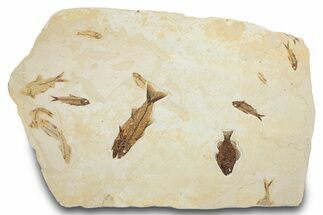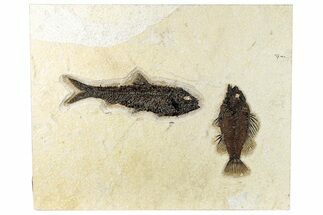This Specimen has been sold.
Excellent 5.7" Priscacara Fish Fossil
Here is a very beautiful and elegant fossil fish from the Green River Formation, a Cockerellites liops. It shows great preservation and detail and is presented nicely in the middle of large rectangular slap of natural matrix. It's 5.7" long which is good size from a Priscara and centered on a solid 16x14 slab of matrix. It would be quite suitable for framing and upon request we can cut the matrix down to a custom size at no charge (which will also significantly reduce shipping costs)
It was collected from the 18 inch layer which produces much darker and well defined fish fossils than the split fish layers. When the fish are found in this layer they are completely covered with rock, which must be professionally removed using hand tools, a process that takes many hours. Like nearly all fish from the 18 inch layer there is some minor restoration where pieces flake up during preparation but the fish has not been painted, like many on the market.
It was collected from the 18 inch layer which produces much darker and well defined fish fossils than the split fish layers. When the fish are found in this layer they are completely covered with rock, which must be professionally removed using hand tools, a process that takes many hours. Like nearly all fish from the 18 inch layer there is some minor restoration where pieces flake up during preparation but the fish has not been painted, like many on the market.
Cockerellites liops is a species of extinct temperate bass found in the Eocene aged Green River Formation of Wyoming. It is characterized by a sunfish-like body and its stout dorsal and anal spines. It was originally placed in the Priscacara genus but was moved to the newly created genus Cockerellites by D. Jordan and H. Hanibal in 1923. There is still some debate among researchers about whether this new genus is valid.
Cockerellites is found in large numbers in mid-lake deposits, representing 5 to 20 percent of the fish unearthed, depending on the layer. It is considerably rarer in shoreline deposits, representing only 1 to 2 percent of the fish found. Because of this, Cockerellites is thought to have been a schooling fish. Fossils have been found at a maximum size of about six inches, but they rarely exceed five inches in length.
At first glance, Cockerellites liops has a very similar appearance to the rarer species Priscacara. Size can often be used as a differentiator, since Cockerellites did not exceed 6 inches while Priscacara serrata is typically found in excess of 6 inches. Cockerellites also has more dorsal and anal fin rays than Priscacara and a much smaller mouth.
Cockerellites is found in large numbers in mid-lake deposits, representing 5 to 20 percent of the fish unearthed, depending on the layer. It is considerably rarer in shoreline deposits, representing only 1 to 2 percent of the fish found. Because of this, Cockerellites is thought to have been a schooling fish. Fossils have been found at a maximum size of about six inches, but they rarely exceed five inches in length.
At first glance, Cockerellites liops has a very similar appearance to the rarer species Priscacara. Size can often be used as a differentiator, since Cockerellites did not exceed 6 inches while Priscacara serrata is typically found in excess of 6 inches. Cockerellites also has more dorsal and anal fin rays than Priscacara and a much smaller mouth.
SPECIES
Cockerellites liops
LOCATION
Kemmerer, Wyoming
FORMATION
Green River Formation
SIZE
5.7" long on 16x14" Matrix
CATEGORY
SUB CATEGORY
ITEM
#5970
We guarantee the authenticity of all of our specimens.
 Reviews
Reviews













